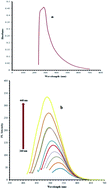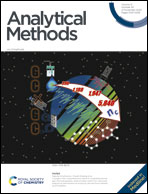An innovative highly sensitive electrochemical sensor based on modified electrode with carbon quantum dots and multiwall carbon nanotubes for determination of methadone hydrochloride in real samples
Abstract
In the present work, to enhance the properties of a pencil graphite electrode (PGE), highly functionalized carbon quantum dots (CQDs) were synthesized and mixed with multiwall carbon nanotubes (MWCNTs) as novel modifiers for the preparation of working electrodes. These modifiers exhibited unique characteristics owing to the fascinating and well-defined properties of the CQD-MWCNT nanocomposite, including high surface to volume ratio, high conductivity, high stability and excellent electrocatalytic activity. Consequently, a modified pencil graphite electrode based on poly (diallyldimethylammonium chloride) (PDDA)/MWCNT/CQD was used to monitor the oxidation signals of methadone hydrochloride. Notably, field emission scanning electron microscopy (FE-SEM) was used to characterize the morphology and features of the different modifiers on the electrode surface. The proposed sensor was characterized via electrochemical studies including differential pulse voltammetry (DPV) and electrochemical impedance spectroscopy (EIS). Under the optimum experimental conditions, the current response and concentration of methadone exhibited a linear relationship in the range of 0.1–225 μM with a detection limit of 0.03 μM. Furthermore, this sensor was successfully applied to determine methadone in human urine and plasma samples.



 Please wait while we load your content...
Please wait while we load your content...